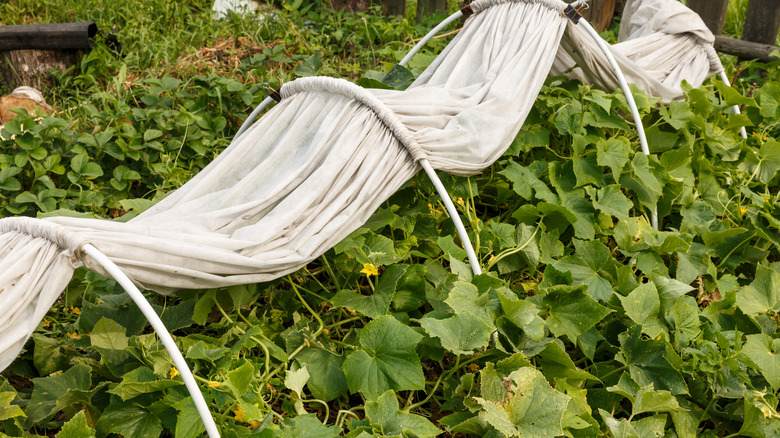Are Cucumber Plants Doomed With The First Frost Of Winter? Here's What We Found
Cucumber plants are a summer garden favorite among most gardeners, featuring fast-growing vines that thrive in warm weather. There are many different cucumber varieties you can plant at home and lots of information available on how to grow cucumbers successfully. Even the TikTok gardening community has helpful tips to start growing cucumbers. These popular vegetables are typically harvested from mid-summer through early fall, but as temperatures begin to drop, you may be wondering if your cucumbers are doomed when the first frost of winter comes. While "doomed" may be a strong word, the unfortunate truth is that cucumbers are fragile when it comes to cold temperatures and frost and don't handle even a mild frost well. However, protecting your cucumber plants can keep the frost and cold from killing the plants if it is done properly — before the cold temps or frost hits.
Timing is everything when it comes to protecting your cucumbers. Many gardeners and farmers will regularly watch the weather via the news, or they may even have a home weather station. This helps them prepare for any inclement weather coming that may damage their crops and plants. Surprise weather can happen, but usually the reports are reliable and can help you prepare. If you know ahead of time that frost or cold temperatures are predicted, you can cover your cucumbers and other frost-fragile veggies before cold weather destroys your harvest. The ideal temperature for cucumbers is 75 to 85 degrees Fahrenheit. Damage can occur with prolonged exposure to temperatures 50 degrees Fahrenheit and lower. This damage includes pitting, cracking of the cucumber's skin, decay, and brownish areas on the skin.
How to protect your cucumber plants from frost and cold temperatures
There are a few things you can do when you first plant your cucumbers that can make protecting them from cold weather easier and more effective. When choosing a spot to plant your cucumbers, choose areas that are sheltered from the elements. Open areas and low spots are a magnet for cold air which makes it harder to protect the plants. You should ideally grow your cucumbers along a stretch of fence, a row of shrubs, or a rock wall which will help block the tender plants from the cold. You can also use a large board or thick, heavy duty cardboard shoved into the ground on the side of the plant that the wind is coming from which will block the wind from damaging the plants. Make sure the boards are secure and won't fall over onto the plants.
Covering your cucumbers to protect them from the cold is crucial to protecting them. Cover your cucumber plants with old sheets, lightweight blankets, table clothes, or even curtains when frost is imminent. You can also purchase row covers online — just make sure you choose one that is thick enough to protect from frost. Heavy weight covers will handle temperatures as low as 26 degrees Fahrenheit, but medium and light weights will offer less protection. Place sticks into the ground around your plants over which to drape the covers to form a tent that will go over the plants. Some gardeners use coat hangers to form arches. Tie the ends of the fabric to the wire arches or sticks so they don't blow away. During the day, raise the row cover up and "open" the rows so any condensation can evaporate and the plants can be pollinated.

